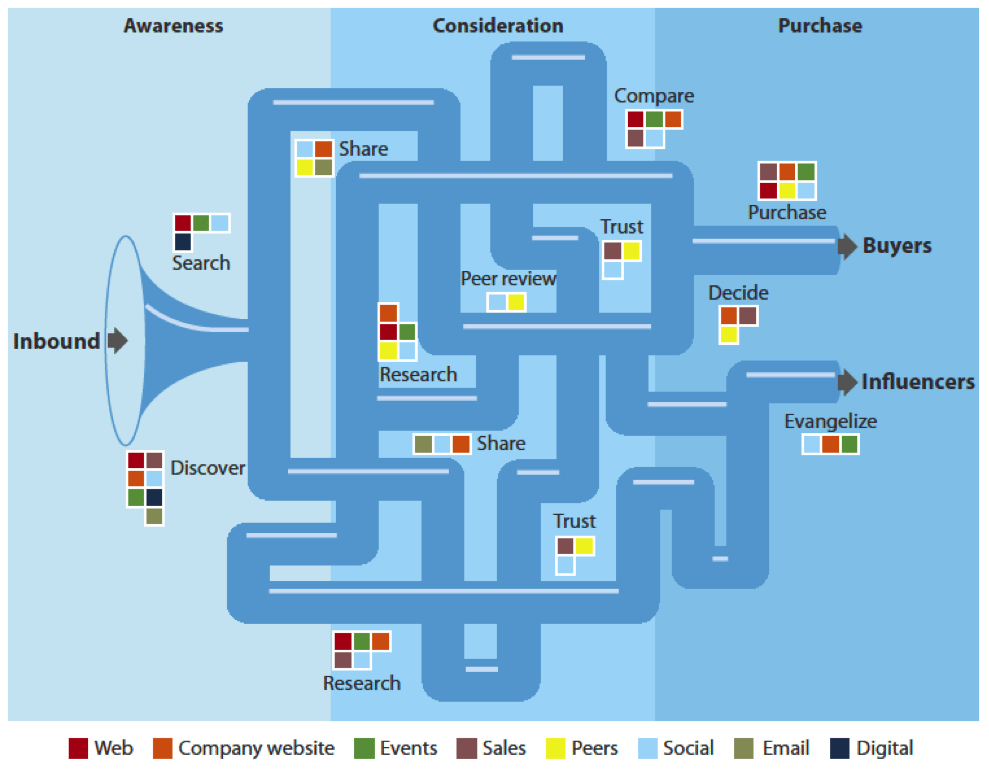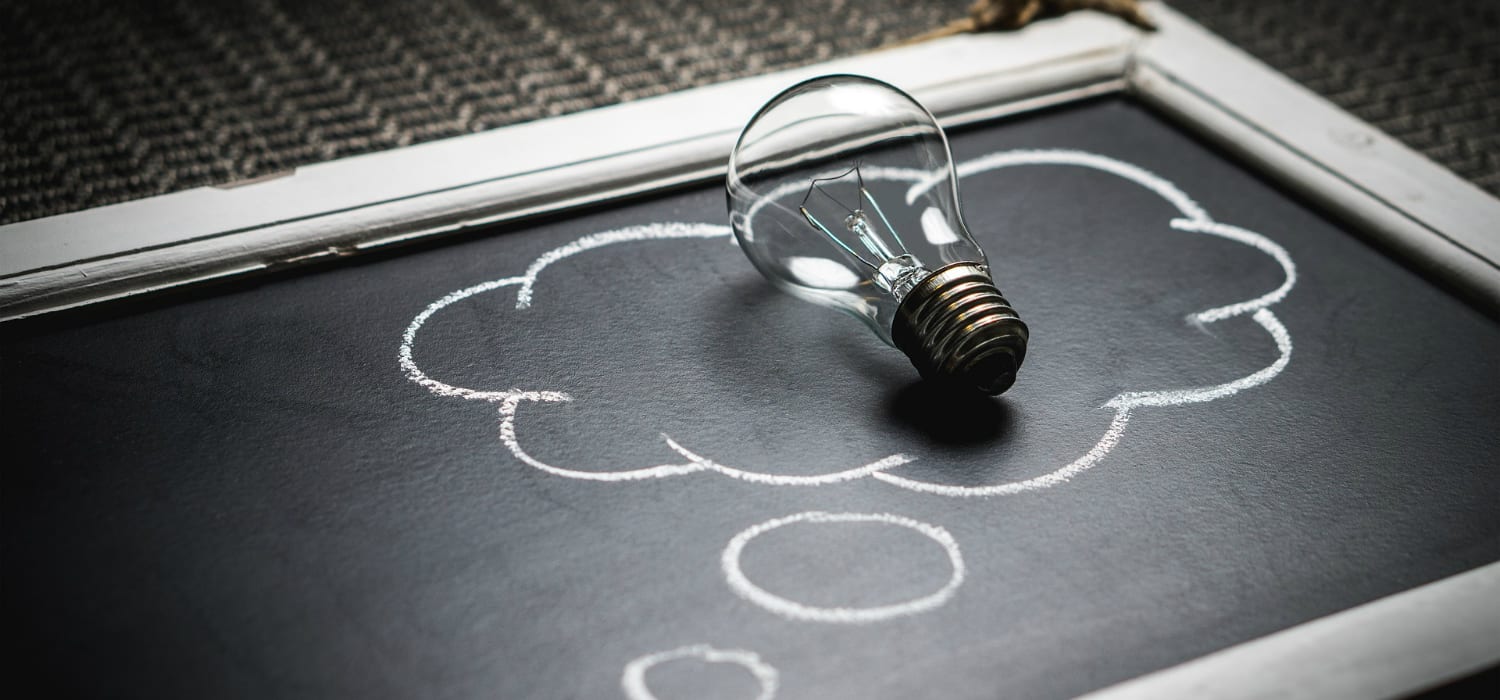It’s easy for content marketers to brainstorm a list of topics to create content about and get busy, but to produce a really effective campaign, you need to take a more considered approach that recognizes the immense importance of the buyer’s journey.
The buyer’s journey is a simple framework that explains the following three steps a customer takes when making a purchase decision:
- Awareness – Where the buyer first becomes aware of your brand while looking for answers, resources and potential solutions to a problem.
- Consideration – At this point, the buyer evaluates potential solutions.
- Decision – Finally, the buyer decides whether or not to buy what you’re offering
When the buyer’s journey works in your favor, from the marketer’s perspective it’s helpful to view the buyer as progressing through the stages of knowing, then liking, then trusting your brand.
The sales funnel model.
Sales and marketing teams often depict these processes as a sales funnel model, although this model isn’t always simple or linear.
Forrester created this maze-like diagram to demonstrate the unpredictable path a buyer may take across an ever-expanding array of channels.

While the reality is that the prospective buyer will bounce around en route to the purchase, it’s important not to overthink it. The one crucial question you need to answer is simply: what content must you create to satisfy the informational needs of your customers across each stage of their buying journey?
How to get started mapping content for the buyer’s journey
The following tips will help get this process started:
- Create a list of questions people ask at each stage of their buying cycle
- Audit your existing content and determine where it fits into the funnel
- Identify the gaps. Where does your content fall short of delivering useful answers?
- Make a list of content that will help fill in these gaps
- Get to work
Now let’s take a closer look at the three stages in the buyer’s journey and how your messaging will vary.
The awareness stage.

At the awareness stage, your content should focus on the buyer’s pain points, not your brand.
Your buyer is trying to solve a problem and find answers to questions. A sale isn’t necessarily imminent, but trust-inducing and objective educational content will point buyers in the right direction and, hopefully, leave them wanting more.
The list of potential content types to consider is long:
- Blog posts
- Videos
- Infographics
- Quizzes and interactive content
- Tools
- Checklists
- Webinars
- Research studies
- Ebooks
- Social content
I was initially reluctant to create this list and call it awareness stage content, because each of the above also has the potential to serve the buyer’s needs in subsequent stages. In the awareness stage, however, and at every stage, it’s wise to anticipate the channels that will either expose or lead your prospect to the content. Obvious questions regarding channels at this stage (or at the top of the funnel) might include:
Search
- What keywords will help the content be discoverable via search?
- How can you create the level of quality needed to rank in search results?
- How might you craft content that authoritative publishers will link to?
Social media
- Which are the best channels to use to promote your content?
- Does your content have verbal and visual elements that will increase its chances of getting shared?
Advertising
- How will the content best fulfil the promise of the ad?
- Should your content have a dedicated landing page?
Then what? If your awareness stage content is helpful and compelling, it might inspire the buyer to journey forth into the next phase of your funnel.
At this point, you need to establish the action you want your prospect to take:
- Do you want your prospect to share, subscribe, call or contact, buy, try or take some other action?
- Accordingly, does your content offer a clear call to action?
- Will an incentive help increase your conversion rate?
The consideration stage.

When prospects reach the middle of your funnel they’re closer to buying. They’ve likely stepped-up their problem-solving efforts and are taking various factors into consideration as they evaluate their options.
It’s worth noting that the consideration stage varies widely depending on the product or service. For consumer-facing content, middle of the funnel considerations might be minimal (e.g. foods or clothing) or not (e.g. electronics, vehicles, or professional services).
In most B2B instances, the consideration stage is often more intricate, it may take longer, and could involve additional decision-makers.
Plan your content accordingly and map it to specific questions prospects ask in both cases.
None of the content types covered in the awareness section above are out-of-bounds, however, mapping content to mid-funnel content demands may benefit from:
- Case studies
- Samples
- FAQs
- Sales collateral
- Product/service comparisons
- Lead nurture emails
- Reviews
It’s important to understand that while the content you create for the consideration stage may maintain a degree of objectivity, it shouldn’t shy away from introducing the merits of your solution and brand.
In the interest of the bottom line, you should aim to communicate why your solution is — or isn’t—a fit. In many product categories, going overboard to recruit an ill-fitted customer can backfire. In the interest of long-term success, maintain your integrity and continue to focus on being helpful and forthright.
Again, let’s examine some channel-specific considerations:
- If you’ve built email opt-in mechanisms into your funnel, follow-up is likely to employ email and marketing automation to promote your content.
Social and search
- Consider again the social media and search guidelines presented above.
- For search, explore keywords that suggest the prospect is actively shopping. For instance, you might target phrases including words such as: tool, service, product, solution, supplier, reviews, pros and cons, and “vs.”
- To increase reach and/or audience focus, social media efforts could be stepped-up to target and deliver content to specific prospects and groups.
Advertising
- To effectively promote the content buyers depend on for evaluating products and services use native ads, content discovery feeds, and all forms of online advertising.
- Search ads might feature specific features and benefits.
Traditional media
- Will it make sense to use direct mail, radio, or television to promote your content?
- Is the content you created worthy of being printed to distribute at events?
How to Create Genuine Native Content
The decision stage.

The decision stage is probably the most neglected by content creators. It tends to veer away from blogging and social media as it wanders largely into the sales realm.
Therein lies a great opportunity, however, to align sales and marketing departments, collaborate on strategy and content creation, and consider options not so much for distribution, but for delivery.
Being brand-specific with your content at this stage is key. Again, many of the previously discussed content types could be fair game. An ideal forum to close sales, for instance, is a webinar; and, case studies can highlight specific details, applications for your product or service, etc.
Additional content types ideal for the decision stage of your sales process might include:
- Product presentations (meeting support materials)
- Product pages
- Pricing information or tiers
- Detailed tutorials
- Proposals
- Special offers
Interactions often become one-to-one in the decision stage. While this might cause you to reconsider some media types, it certainly does not exclude important digital touch points, including email and social.
Where are we in this journey?
I hope the answer is obvious. The blog post you’re about to finish reading is top of the funnel content. I haven’t said a word about Taboola – until now.
As I explained, however, effective top-of-the-funnel content aims to generate leads and inspire action. So I’ll have to ask:
Are you interested in learning more about the world’s leading content-discovery platform? Read on to find out:
- How to funnel your way into customer success stories and many more valuable resources worthy of your consideration
- Learn how to create your first campaign
- Discover why your social media sharing is down
- The B2B lead generation strategies and ideas that you need